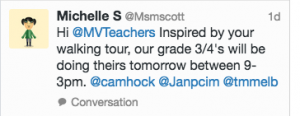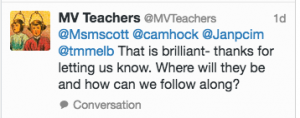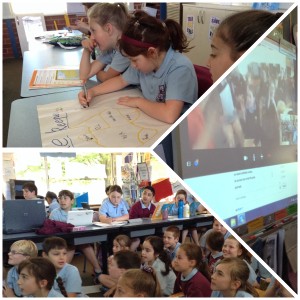Reflecting on the year at our school, a major theme would have to be CONNECTING. A few examples follow …

In the past week, I have watched our classes finish up for the school year – the usual gift giving, carol singing, graduation ceremonies, packing, moving classes and reminiscing. This year our classes had not only to say good-bye to each other, they needed to acknowledge connections they had created throughout the year via their blogs. Five classes joined together to create a particularly Australian Christmas message for their blogging friends. They continued to appreciate, as they had all year, that they had a unique story to tell their buddies in NZ, Canada, USA and the UK. “What’s a ute?”, came back a reply from Canada, highlighting our individuality.
Our recently graduated Preps prepared a movie (cleverly orchestrated by teachers but filmed, written and performed by the students) for the incoming class of preps introducing them to their school. They were ‘Taking Action’ after spending the term examining their community – sharing their knowledge and experience and connecting with the newest members of our community.
Our Middle students connected with US students when inquiring about endangered animals and a wonderful learning opportunity developed. They also shared and received feedback on their writing from a diverse group of readers through their class blogs.
Our Community Arts Project recently culminated in the unveiling of a montage of family photographic images – connecting the families to the school community being a major focus of this project. The project also connected our students as a peer mentoring process was put into action.
All members of our staff have participated in Professional Learning sessions most Wednesday mornings (Techie Brekkie’s) where we share new tech skills and tools and learn alongside each other. We were connecting as learners as we acknowledge our individual needs and skills. The staff has also recently planned to further the connections with other schools as well as create opportunities for more collaboration within our school, benefiting both the teaching staff and students alike. Many staff have continued to embrace the world of Twitter and blogging as an amazing opportunity to connect with other educators and our school is richer for this process.
Whether it be in the physical sense of a Better Buddies program, Junior students making a luncheon for our Parish senior citizens, having grandparents come to school to share their stories of the past or singing carols at a nearby nursing home or in the virtual sense through our on-line connections, connecting is a vital aspect of our daily lives in school. The days of closed doors are over !
Personally, I have loved the opportunities that I have had this year to have face-to-face meetings with people I had only previously connected with on-line – the first Melbourne TeachMeet in September and a trip to Sydney to work with the George and Alec Couros at Ravenswood School being highlights. A key thought from that conference was that ‘Learning is Social’ and I believe we have demonstrated that well.
It is often easy to be self critical, to not appreciate things whilst you are too close to see them properly. It is hard to remember how things were before when we so quickly become accustomed to them in our lives. I hereby acknowledge the efforts and appreciate them ! Thanks to all the people who make these things happen – you know who you are.
Image: Salvatore Vuono / FreeDigitalPhotos.net




